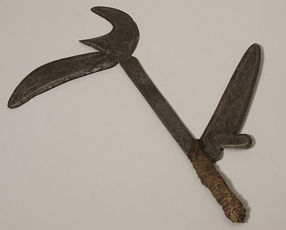Choosing the Right Throwing Knife
 Using throwing knives is an art form, but you can easily learn and become an efficient knife thrower. Knife throwing has been long used in battle due to the swiftness of its use.
Using throwing knives is an art form, but you can easily learn and become an efficient knife thrower. Knife throwing has been long used in battle due to the swiftness of its use.
The Kpinga
A good example of the use of a throwing knife used for defence is the the Azande, an African tribe created the ‘Kpinga’ which is a 3 pronged throwing knife, which was banned in much of Africa due to it’s ability to take out an opponents legs in one swift movement. The Kpinga was known to be a long distance weapon that hit its target with surprising accuracy.
The upside is that a skilled thrower can eliminate a target swiftly, however the downside is that you have lost your weapon and you must approach to retrieve. Knife throwing has become an entertainment staple, with many knife throwers gaining notoriety in the traveling show circuit last century.
What Sort of Throwing Knife is Best for Me?
There are different types of throwing knives, each with it’s own unique qualities and knowing the difference can give you a better chance at a good shot.
The first thing is to choose the right knife for your planned activity. There are three different kinds of knives that are ideal for throwing: choose from a blade-heavy knife, handle-heavy or balanced knives. Balanced knives are usually chosen by beginners so they can switch easily to other models. Balanced knives are also ideal for smaller throwing distances as the weight is distributed evenly through the knife. Blade or handle heavy knives are suited to throwing distances over 5 metres.
Throwing Knife Blade to Handle Weight Ratio
Different knives will have differing blade-to-handle weight ratios. This means that the location of their centre of balance (fulcrum) will always differ. Some throwers swear that a knife with .jpg) a perfectly centred fulcrum is better suited for throwing, whilst others argue that the lack of balance is what gives the throwing knife the momentum it needs to spin easily to its target.
a perfectly centred fulcrum is better suited for throwing, whilst others argue that the lack of balance is what gives the throwing knife the momentum it needs to spin easily to its target.
We suggest experimenting with several types of knife to find one which suits your throwing style.
When choosing a knife, remember that a good throwing knife doesn’t need a special handle. If you choose a knife that is light enough to throw you should have no problems throwing it and reaching a target. Choose a target that is suitable for the kind of knife you have, for example your knife may break glass and penetrate the window, but this will damage the tip of your blade.
Throwing knives feature blunt blades and a sharp tip, this ensures that it can impale itself on the target easily, without cutting your fingers during the throw.
Keep in mind that you want the weighted end of the knife to be thrown first, so if you are throwing a blade-heavy knife, the blade end will be thrown first by holding the handle. And vice versa – if you’re throwing a handle-heavy knife, you will throw it by the blade. The lightest part of the knife will be in your hand to prepare for the throw.
Always exercise extreme caution when using knives, in order to avoid accidents and injury.
Please read our other posts for tips on stance for throwing and throwing techniques.

